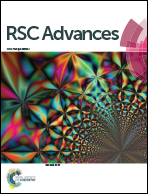Photoageing of cardanol: characterization, circumvention by side chain methoxylation and application for photocrosslinkable polymers†
Abstract
The photosensitivity of cardanol has been evaluated using a multi-technique approach. Among other techniques, size exclusion chromatography, matrix assisted laser desorption ionization mass spectrometry and their off line coupling provided useful details on the macroscopically observed yellowing and insolubility of cardanol under UV activation by analyzing photoproducts at the molecular level. Evidencing the implication of the unsaturations borne by the cardanol side chain in a crosslinking process, an original synthesis route leading to its complete methoxylation has been proposed as a way to lower the photosensitivity of cardanol. Using a similar set of analytical techniques, this newly synthesized methoxylated cardanol has appeared more resistant towards UV exposure, without any crosslinking but a simple dimerization preserving its solubility. As a direct application, copolymers made from methyl methacrylate, cardanol and methoxylated cardanol have been synthesized, and their photocrosslinking ability was found to depend on the content of the two latter co-monomers, as a preliminary step towards the production of photocrosslinkable bio-based polymers with a tunable UV curing propensity.


 Please wait while we load your content...
Please wait while we load your content...